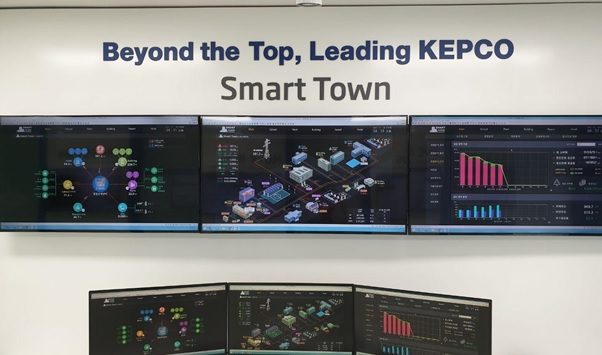WOOHYUN HWANG
SEPTEMBER 27, 2020
I. INTRODUCTION
In this Special Report, Woohyun Hwang describes the current status and recent development of microgrids based on renewable energy sources and other generation in the Republic of Korea (ROK). The types of microgrids constructed in the ROK are described, along with policies related to microgrid development and implementation, and financing arrangements for microgrids in the ROK. The paper includes an prologue on the impact of the covid-19 pandemic on microgrids in the ROK.
A summary of this report follows. A downloadable PDF file of the full report is here.
Woohyun Hwang is Professor, Seoul National University of Science and Technology.
This report was produced for the Regional Energy Security (RES) Project funded by the John D. and Catherine T. MacArthur Foundation and presented at the RES Working Group Meeting, Tuushin Best Western Premier Hotel, Ulaanbaatar, Mongolia, December 9-11, 2019.
The views expressed in this report do not necessarily reflect the official policy or position of the Nautilus Institute. Readers should note that Nautilus seeks a diversity of views and opinions on significant topics in order to identify common ground.
This report is published under a 4.0 International Creative Commons License the terms of which are found here.
Banner image: Status monitors for Smart Town microgrid at the KEPCO Human Resources Development Institute, photo by Woohyun Hwang.
II. NAPSNET SPECIAL REPORT BY WOOHYUN HWANG
MICROGRIDS FOR ELECTRICITY GENERATION IN THE REPUBLIC OF KOREA
WOOHYUN HWANG
SEPTEMBER 27, 2020
Summary
Different types of Korean microgrid technology have been developed and commercialized as a part of the Jeju Smart Grid Test Bed program since 2010. Microgrid commercialization models are divided into self-sufficient and grid-linked types according to where the microgrids are used. Beginning in 2011, the commercialized microgrid models had been installed at 1,247 sites in Korea by the end of 2018. The government plans to expand renewable generation to 63.8 GW from renewable energy sources by 2030, based on the Republic of Korea’s (ROK’s) commitment to emissions reduction following the 2015 Paris Agreement to the United Nations Framework Convention on Climate Change (UNFCCC). The ROK’s commitments are supported by various policies and implementation budgets.
1. Introduction
1.1 Brief Summary of the Status of Mini- and Micro-grids in the Republic of Korea
Korean microgrids (MG) have been launched through small-scale R&D efforts since 2007 in universities, research institutes and private companies. Large-scale government-led smart grid projects have been underway since 2009 at the Jeju Test Bed, with the goals of verifying microgrid technology grid stabilization, demonstration of economic feasibility, and development of business models for commercialization. Currently, the local government, utilities, private companies, and individuals are developing a range of microgrid businesses based on government policy and utility regulations using developed business models.
1.2 Current and Planned Policies ROK Regarding MG
Government plans call for the installation of up to 63.8 GW of renewable energy, producing 20% of national generation, and reducing national CO2 emissions by 37% by 2030 as a part of fulfilling the ROK’s commitment to the 2015 Paris climate change agreement. Government subsidies are provided for renewable energy sources such as solar, wind, and bio energy and power producers are obligated to incorporate renewable generation in their generation portfolios through the use of renewable energy credits (RECs).
1.3 Map to Remainder of Paper
This paper introduces the evolution and development of microgrids and related smart grid development based on plans by the national government, local governments, and power companies during the last 10 years in Korea, and presents the results of and prospects for microgrid development in Korea.
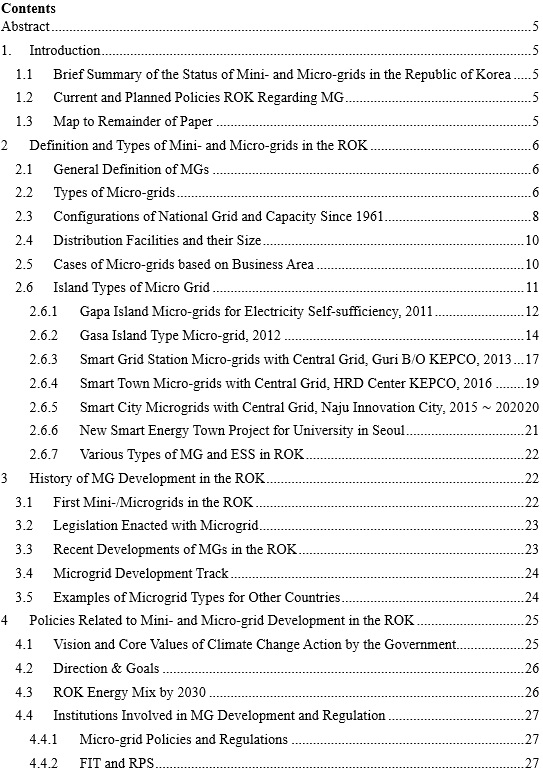
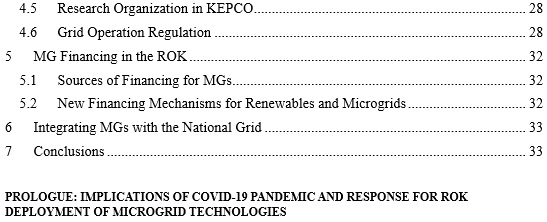
2. Definition and Types of Mini- and Micro-grids in the ROK
2.1 General Definition of MGs
Microgrids are defined in Korea as installations that connect renewable electricity generation with energy storage systems to produce electricity and supply it in conjunction with the central grid or use it independently. The renewable energy resources used in microgrids are primarily photovoltaic, wind and small hydropower or bioenergy generation. Energy Storage Systems consist of lithium-ion or lithium phosphate batteries, power control systems, and operating software (Figure 1). There are three types of Micro grids in Korea, as described below.
Figure 1: Microgrid configuration
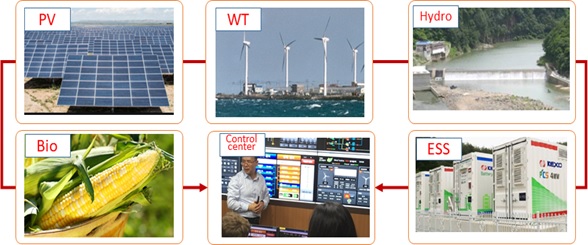
2.2 Types of Micro-grids
In Korea, three types of microgrids are used: self-sufficient, islanded, and connected to the central grid. The power generation, conversion, and storage technologies used in of each instance can be the same, depending on the purpose of that the microgrid is used for. Microgrids can be backed up by diesel generators, either connected or not connected to the central grid, or backed up with a central grid connection, as shown in Table 1. Self-sufficient microgrids that are not linked to diesel generators or to the central grid produce 100% of the electricity needed by the loads to which they are connected from wind, solar power and the microgrid’s ESS. Depending, on the other hand, on the method of linking the microgrid with supporting generation by diesels or the central grid, the microgrid can operate above the limited allowance of the size of renewable energy sources or ESS capacity in the microgrid.
Table 1: Types of Microgrids and their Features
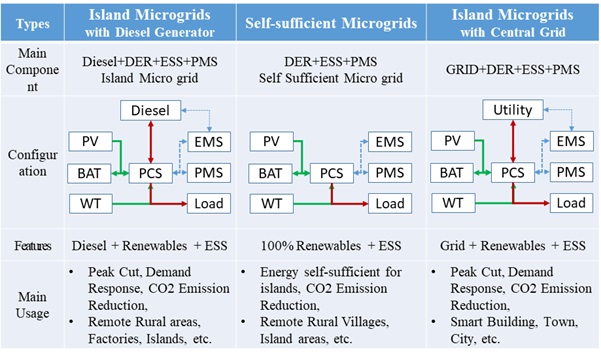
The purposes of these three microgrid models are to reduce peak demand, provide demand response, and reduce carbon dioxide emissions. Self-sufficient and island type microgrids can provide power to remote islands and rural areas without the need for long-distance transmission and distribution networks. Connected central grid types are also used to supply renewable energy for buildings and cities. Most microgrid configurations are equipped with solar, wind, battery and PCS (power conditioning systems) and PMS (power management systems), and are managed by EMS (energy management systems) in conjunction with the load. The self-sufficient type of microgrid operates the same as a diesel generator except for the generator, and the island type is not connected to the national central power system. The operational stability of these three types of micro grid systems are denoted as central grid, island and self-sufficient.
In terms of economics, there is no big difference between these types of microgrids because each model is similar. However, the 100% self-sufficient type requires the additional power to be backed up in the event of bad weather or equipment failure. On the other hand, the diesel generator and central grid connection type do not require much backup battery capacity compared to the independent type, and are therefore less expensive and are stable from an operating perspective.
2.3 Configurations of National Grid and Capacity Since 1961
As of the end of 2018, the capacity of power generation facilities such as nuclear power, coal, gas, and renewable energy in Korea totaled 119 GW. The transmission grid system operates at 765,000V, 345,000V, and 154,000V, and substations for each voltage are installed between the transmission grid and the distribution lines to supply power by stepping down the transmission voltage. Distribution voltage is typically 22.9kV, with low voltage power at 220V and 380V supplied to households and businesses (see Figure 2).
Figure 2: National Grid Configurations
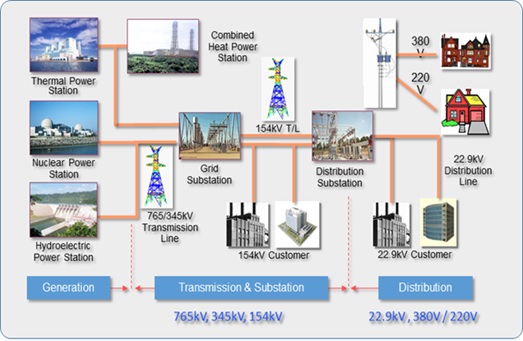
Since 1961, these facilities have grown through planned power development, transmission and distribution network expansion, power to serve the telephone business, voltage boosting, and automation of grid operation in accordance with the national economic development plan (see . With the construction of large-scale apartment complexes and industrial complexes in the 1980s and 1990s, cogeneration plants were connected to the grid to provide power and district heat. In 2010, use of renewables such as solar and wind power started to increase. The access of microgrids to the national grid has been since increasing and the capacity of renewable energy sources of electricity stood at 13 GW as of the end of 2018.
The capacity and fractions of capacity provided by the types of major power plants operating in Korea are as shown in. As nuclear power and renewable energy sources account for 30% and thermal and gas power account for 65% of generation, the portion of fossil fuels is still high. On the other hand, the capacity of renewable energy sources, such as wind and solar, had reached 10 GW by 2018.
Figure 3: Status of Central Transmission Lines since 1961
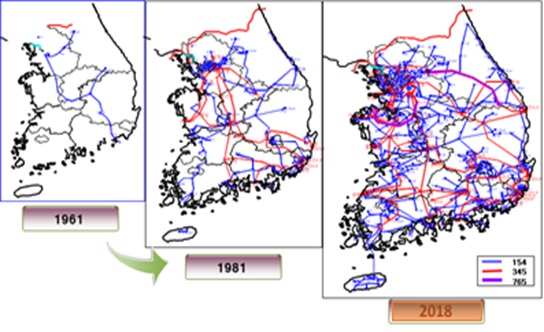
 The transmission grid, which supplies power to the whole country, includes lines (T/L in Table 3) 33,955 c-km (conductor-kilometers) in length, the national substation (S/S) capacity is 311,869 MVA, and the number of electricity customers is 23 million, with annual sales volume of 507 TWh and peak power demand of 92.5 million kW.
The transmission grid, which supplies power to the whole country, includes lines (T/L in Table 3) 33,955 c-km (conductor-kilometers) in length, the national substation (S/S) capacity is 311,869 MVA, and the number of electricity customers is 23 million, with annual sales volume of 507 TWh and peak power demand of 92.5 million kW.

2.4 Distribution Facilities and their Size
As shown in Figure 4, Korea’s distribution facilities have increased by more than 50 times in terms of number of electric poles and the length of distribution lines, and the transformer capacity in the ROK had grown by a factor of 170 as of 2017 compared to the situation in 1961. The ROK national grid has been supplying electricity generated using relatively cheap nuclear power and fossil fuels through the national transmission and distribution network. The central grid coverage rate for the nation as a whole is almost 100% (DAS in Table 3). Therefore, there was previously little need to introduce microgrids such as solar and wind power.
Figure 4 Distribution Facility
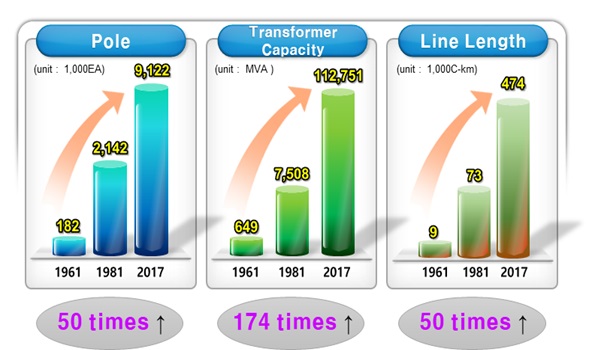
2.5 Cases of Micro-grids based on Business Area
Figure 5 shows examples of microgrid businss types in Korea from 2011 through 2015.
Figure 5: Examples of Micro Business Types
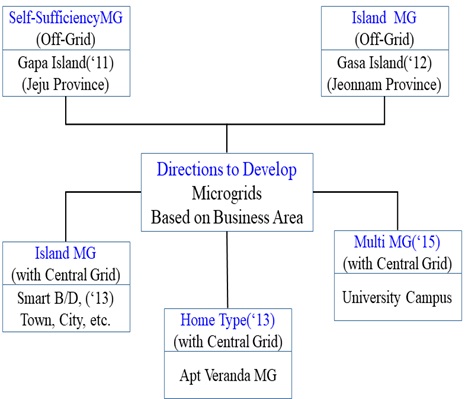
In 2005, climate change issues were first raised seriously in Korea. In 2009, when the development of the smart grid test bed began in earnest, microgrid technology began to be develop and applied in the ROK. Five main business models have been created. In 2011, we developed the energy-independent microgrid in Jeju-do, Gapdo, representing the first commercialized microgrid in Korea. In 2013, the central power grid was connected to the KEPCO (Korea Electric Power Corporation) Guri Branch office building, and the city of Seoul expanded apartment veranda installations of solar minigrids. In 2015, the KEPCO Human Resources Development Center installed microgrids for nine buildings and is operating those microgrids in connection with the central power grid.
2.6 Island Types of Micro Grid
Island type microgrids are constructed as either self-sufficient type or renewable generation connected with a diesel generator, depending on parameters such as the island size and population. Based on the island location, the power generation equipment choice will consider location-specific conditions such as solar, wind, geothermal, and small hydro resources, and thus may include solar, wind, geothermal, hydro, and/or ESS technologies. Examples of island types of microgrids in the ROK are shown in Table 4, and described below.
Table 4: Island Types of Microgrids
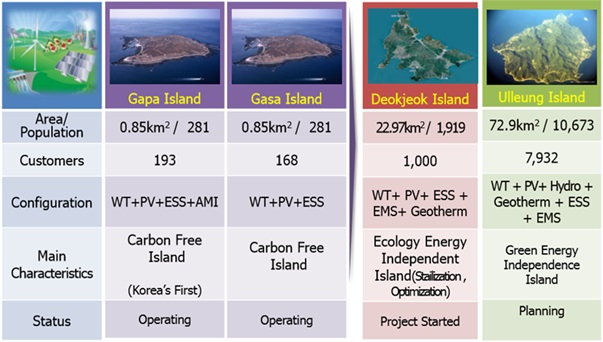
2.6.1 Gapa Island Micro-grids for Electricity Self-sufficiency, 2011
The self-sufficient microgrid was first implemented in the ROK on an island 5.5 km south of Jeju. The island covers an area of 0.86 km2 and has a population of 300. Electricity is produced with three 150 kW diesel generators installed in 1992 and supplied to 196 customers through two distribution lines. The main loads are residential, commercial and desalination facilities. The annual average ocean temperature of the is 16 ℃, the average wind speed is 5.5 m/s, and the maximum wind speed is 13 m/s.
As shown in Figure 6 and Table 5, the Gapa Island self-sufficient microgrid components are similar to those used for grid-connected microgrids. The main power generation facilities are two 250 kW induction wind turbines and 48 household solar generator modules. The generated power is supplied to the load through a 500 kVA × 2, and 250 kVA × 1 power converters and the remaining power above that needed by loads at any given time is stored in a battery bank with a capacity of 3.85 MWh.
Figure 6: Self-Sufficient Microgrid Example, Gapa Island
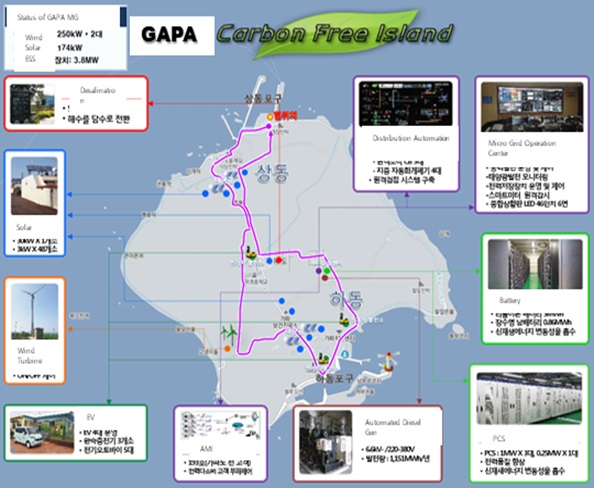

The existing 150 kW × 3 diesel generators remain a part of the Gapa Island system, but operate as backups in case of insufficient power from the renewable energy sources. These systems are controlled by locally-developed operating software and an EMS system (see Figure 7). The Gapa Microgrid model was launched in 2011 and put into operation in the summer of 2012.
Figure 7: Operating Facilities for Gapa island MG
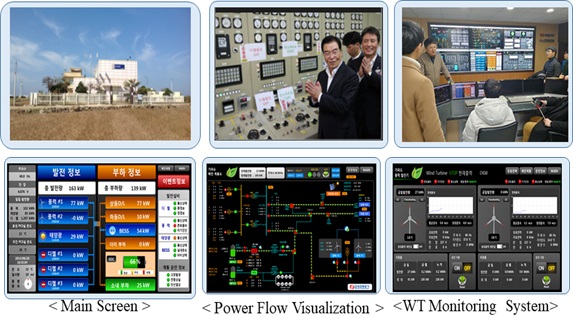
As of 2018, the Gapa Microgrid had a record of operating for up to 7 days using only wind, solar, and batteries. If the system’s battery capacity were doubled, the system could produce and supply electricity from renewable sources only for more than 25 days a month on average. This model has been expanded to include and utilize technologies for domestic smart buildings and smart towns, contributing to the continued expansion of the use of new and renewable energy. In 2016, the Gapa Island MG business signed an agreement with the Dubai Power Authority to share the island microgrid technology and business model. This model has been extended to five islands nationwide, including Incheon and Ulleungdo.
2.6.2 Gasa Island Type Micro-grid, 2012
Located in the southern part of the Korean peninsula (see Figure 8), the Gasado microgrid in Jindo-gun, Jeollanam-do, has an area of 6.4 km2 and serves a population of 301 customers in 164 households and business/institutional consumers (Table 6). The existing power facility installed and operated three 100 kW diesel generators starting in 1992. The distribution lines on in the microgrid have a total length of 8 km. The island’s average annual load is 96 kW, with a peak of 173 kW and a minimum of 61 kW. The main loads are lighthouses, waterworks and military radar bases. When operating with a diesel generator, the island microgrid faced a disadvantage in that altough the voltage and frequency maintenance rate were excellent and the initial investment cost was relatively small, operating cost were high.
Figure 8: Location of Gasa Island
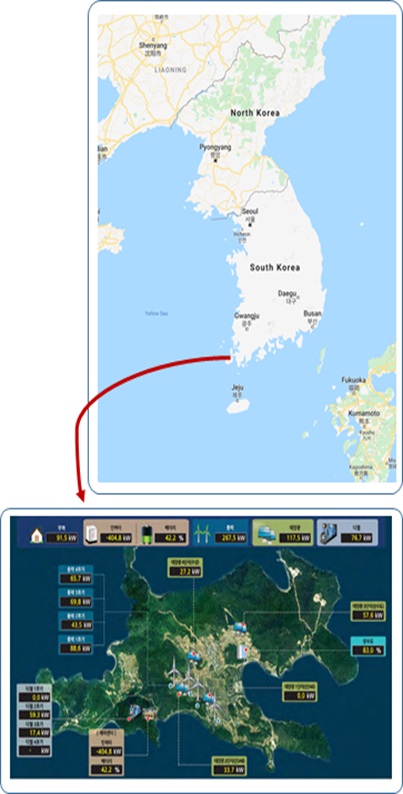

The main facilities and structure of the island microgrid of Gasa as reconfigured with added renewable generation are as follows. Four 100 kW wind generators (WT) were installed and connected using the full Converter method, and the output of the wind generators can be limited if necessary. The design of the island microgrid construction on Gasa Island took into account the characteristics of the island area, considering the installation topography, tracking losses by the wind turbines, and the system operations of the new and renewable power plant facilities. The island microgrid is constructed by interconnecting a renewable energy source and a battery with the microgrid that was powered by a conventional diesel generator system (see Figure 9).
Figure 9: Configuration of Gasa Microgrid
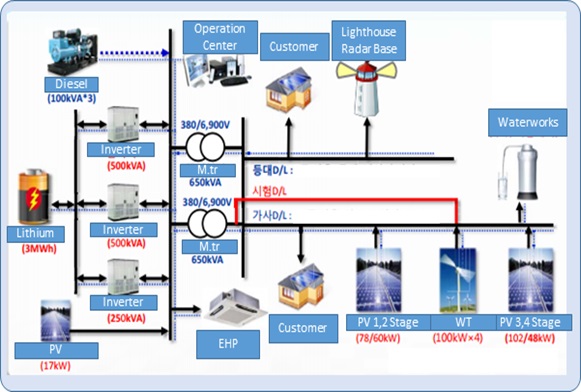
Solar photovoltaic (PV) panels were installed in the Gasa Microgrid as follows: 17 kW were installed at the control center, 78 kW and 60 kW were mounted during the 1st and 2nd stages of the project, and 102 kW and 48 kW were installed in the 3rd and 4th stages of the project.
The inverter for the PCS connects two 500 kVA and one 250 kVA transformer to the bus in parallel to operate with new renewable, battery and diesel generators, as shown in Table 7.

To supply power to consumers, two 650 kVA transformers operating at 380 V/6,900 V are connected in parallel to the lighthouse distribution line (D/L) and the Gas D/L to supply the villagers, Gasa Elementary School, the lighthouse lamp, the water supply pumping station, and the radar base. The diesel generator is configured to compensate for voltage drop remotely.
2.6.3 Smart Grid Station Micro-grids with Central Grid, Guri B/O KEPCO, 2013
The model developed in Gapa, Jeju, was extended to city installations to apply new renewable energy sources to and reduce power consumption in buildings (“smart building” systems).
The goal of the application of smart building technologies for a four-story building at KEPCO’s Guri branch was to reduce power peaks by 5% and consumption by 10%. Solar, Wind, ESS and AMI, IoT sensors, intelligent outlets and lighting devices were installed (see Figure 10). In late 2013, KEPCO installed a system that monitors the outlets and fluorescent lamps connected to office equipment and load devices in offices, meeting rooms, and restrooms. This system automatically cuts off unnecessary loads. The company also remotely monitors and manages electric vehicles with slow chargers and home appliances.
Figure 10 Deployment of Smart Grid Station model

The system installation was completed within two months after launch, and achieved a peak reduction of 5.6% and reduction in consumption of 10.5% in its first year. The system has been expanded to 121 offices nationwide. This system was installed on the roof and included solar and wind power generators as well as an ESS to provide stable operation initially. We have developed and installed a visualized operating system to improve the perception of microgrids by the general public and allow easy management of the microgrid system. Using the visualized operating system, viewers can see the real-time situation in which power is generated by renewables and consumed by loads, and the amount of daily and monthly savings and energy reduction are provided by the system, including year-to-year comparisons.
Figure 11: Main Screen of Smart Grid Station
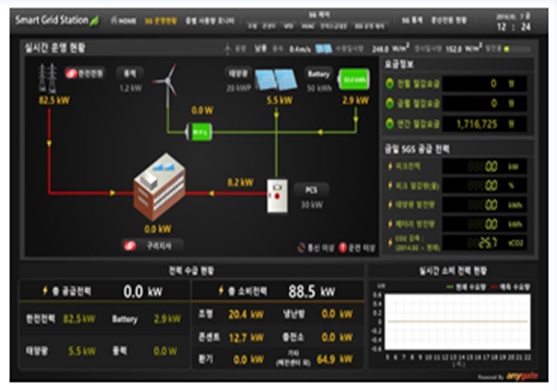
2.6.4 Smart Town Micro-grids with Central Grid, HRD Center KEPCO, 2016
A “Smart Town”-type microgrid was built for 9 buildings of the KEPCO Human Resources Development Institute. The system (see Figure 12) consists of 172 kW of solar power, 1.8 kW of small wind power, 1 kW of demonstration fuel cell, a PCS of 50 kW, a 93 kWh battery pack, and two sets of electric chargers. To manage loads, 302 smart lights. 437 outlets and 111 IoT sensors were installed. EMS systems were installed in the nine buildings.
The system was implemented to reduce power peaks by 10%, reduce power consumption by 10%, reduce fuel costs, and reduce carbon dioxide emissions by 5%. The smart town model was applied to KEPCO’s 31-story building at the end of 2016, resulting in a 25% peak cut and a 30% reduction in electricity usage.
Figure 12: Configuration of Smart Town
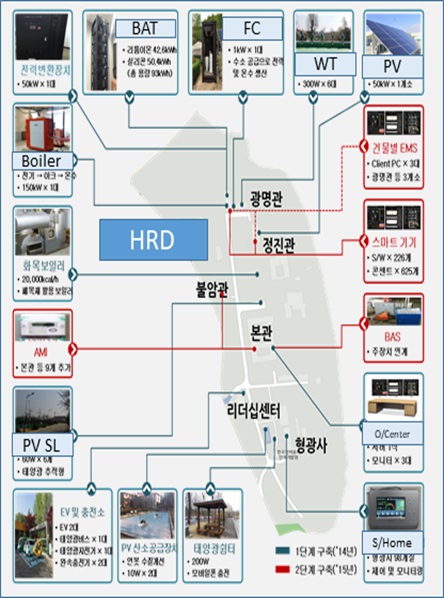
2.6.5 Smart City Microgrids with Central Grid, Naju Innovation City, 2015 ∼ 2020
The self-sufficient microgrid model in the ROK, which started with the Gapa project, has evolved to include the smart building and town microgrid types. As an extension of this evolution, an urban microgrid has been under construction since April 2015. The microgrid will be constructed in Naju, an innovative city of 35,000 inhabitants, aiming to reduce power consumption by 15%, increase the energy independence rate by 30%, and reduce carbon dioxide emissions by 32% (Figure 13 and Table 8).
Figure 13: Configuration of Smart City
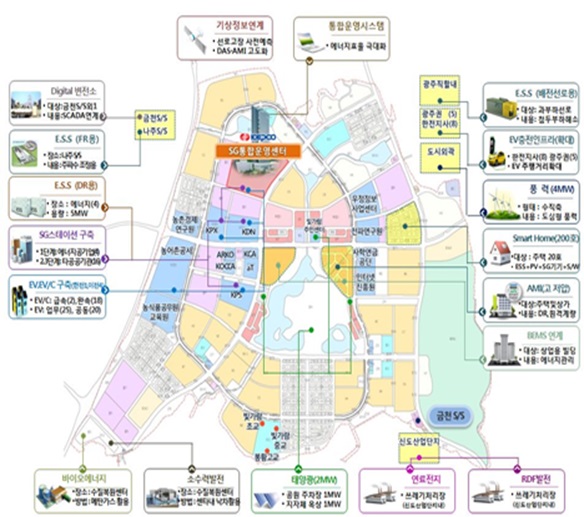

2.6.6 New Smart Energy Town Project for University in Seoul
In order to further enhance the function of the smart city and to develop various operating technologies, research will be carried out in 45 buildings of Seoul National University of Science and Technology to achieve a 30% improvement in power consumption efficiency over the next three years.
2.6.7 Various Types of MG and ESS in ROK
Various microgrids in Korea are operating at a total of 1,267 sites. The number of central power grid-connected solar modules and the ESS account for the largest number of these sites at 602. Installations designed to provide reductions in peak power demand have been built at 586 sites with a total battery capacity of 2.5 GWh. Microgrids designed primarily for output stabilization of wind power generation have been installed at 25 sites, about 2% of the total, and energy self-sufficient microgrids have been installed at 18 sites (see Table 9).
In addition, microgrid concepts are used for frequency regulation microgrid, corporate backup power supply and power company distribution line outage compensation. The total PCS capacity of the MG installations in the ROK are 1.5 GW with a total battery capacity of 4.3 GWh.

3 History of MG Development in the ROK
3.1 First Mini-/Microgrids in the ROK
The development of microgrid technology was carried out for the first time in Korea, in 2007 as a research project pioneered by the government-led development of microgrid integrated energy management systems and the development of test site application technologies. This project aimed to develop the basic structures and elemental technologies of microgrids. A 120 kW scaled-down prototype was built by KERI (Korea Electrotechnical Institute).
The Jeju Smart Grid Test Bed, begun by the government in 2009, demonstrated microgrid technology connecting solar and wind generation with ESS. At the same time, a commercialized model of the energy-independent microgrid was built for the first time in Jeju. This model was designed to be able to supply power produced only from renewable sources, and was successfully built as the first such system in the ROK after one year of preparation. Completion of the project enabled the existing diesel generators at the site to be switched off, and the microgrid was then used to power approximately 200 households with solar and wind power plus battery storage. Diesel generators remain in operation to provide backup power.
3.2 Legislation Enacted with Microgrid
During the development and commercialization of microgrid technology, the government enacted relevant laws to lay the foundation for microgrid proliferation. Starting with the Basic Act on Green Growth, which was enacted in 2006, a variety of legislation had been signed by 2019.
- Low Carbon Green Growth Basic Act (Sept.30, 2016)
- Energy Act (Sept.23, 2016)
- Energy Use Rationalization Act (Aug.12, 2016)
- New Energy & Renewable Energy Development, Use, and Distribution Promotion Act (Sept.23, 2016)
- Collective Energy Business Act (Jan.6, 2016)
- Green Building Support Act (Aug.1, 2019)
- Act on the Construction and Promotion of Smart Grid (Sept.22, 2017)
3.3 Recent Developments of MGs in the ROK
Microgrid technology has recently begun to be applied to smart towns and cities, and has been reflected in relevant legislation.
New Smart Grid Policy (In August 2018 MOTIE Announced the 2nd Smart Grid Basic Plan, Law 2018-432). Main policies include:
- Expansion of Smart Grid new Service
- Construction of Smart Grid Service Complex
- Deployment of Smart Grid Infrastructure
- Foundation of Smart Grid Expansion
- SG Experience Complex, Self-Sufficient Microgrids for Urban Area with Emergency Generator
- AMI, Real time Grid Operation, ICT Infra for Grid
- TOU, Season based Tariff, Consumer DR, Big Data Business, Power Exchange
- Policy Cooperation between Gov’t and Private, Standardization, Privacy Protection
- Investment: $2 billion/5 years
Figure 14 shows the history of Microgrids in the ROK
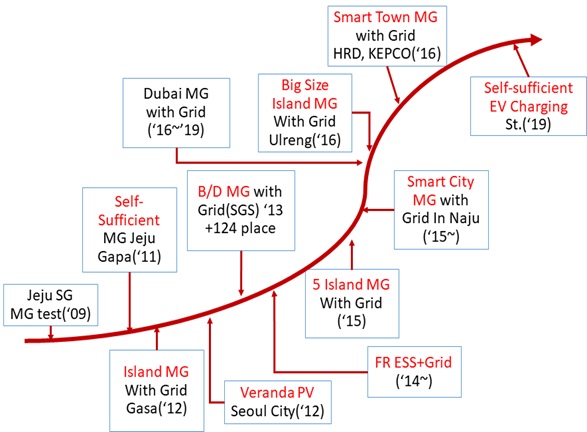
3.4 Microgrid Development Track
Initially, microgrid technology development and market formation in Korea were not made by dedicated agencies or professional investors. The project was started by installing and operating the facilities owned by the participating companies, universities and research institutes within the smart grid test bed, which was initiated in 2009 by the government. KEPCO accelerated microgrid proliferation by developing and supplementing commercial products while demonstrating core technologies. This experience and publicity also contributed to the desire of consumers to use renewable energy. Since then, the smart building type, town type and city type of microgrids have been developed and are spreading.
3.5 Examples of Microgrid Types for Other Countries
Various microgrid models developed in Korea can be shared with neighboring countries in Northeast Asia. Depending on their intended use, users in other nations can build and operate microgrids at the village or city level, as well as in houses, apartments and buildings, as shown in Table 10: Types of MG for Other Countries. Operating software already developed for each purpose can help to interlock systems that include solar, wind, and ESS with the grid under international standards. In any region, there is an advantage that microgrids as modeled in Korea can be operated immediately by installing the required equipment without incurring additional development cost.
Table 10: Types of MG for Other Countries
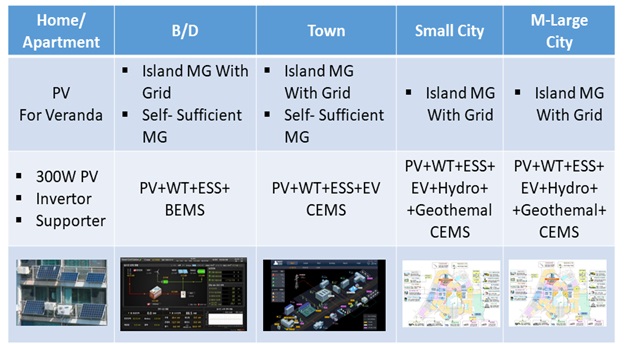
4 Policies Related to Mini- and Micro-grid Development in the ROK
4.1 Vision and Core Values of Climate Change Action by the Government
The Korean government has five policy directions for new energy projects. As shown in Figure 15, government policies focus on safety, growth, the environment, security and coexistence. Among these foci, environment and growth are directly related to microgrids, leading to continuous investment and technology development.
Figure 15: Government Policies
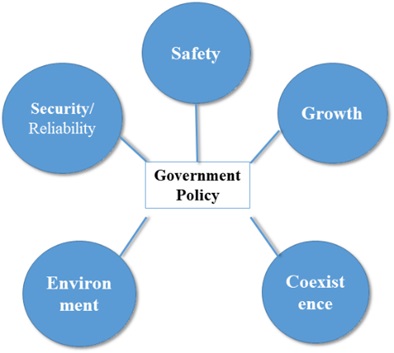
4.2 Direction & Goals
Some of the key directions and goals for energy policy in the ROK as it relates to microgrid development include:
- Clean Energy Rate Target of 20% by 2030
- Clean and Safe Energy Transition
- Increase in GHG Reduction Goal by the Present Government (from 25.7% to 32.5% reduction by 2030)
- The 8th Basic Plan for Power Supply and Demand
- Reinforcement Scenario of Environment and Safety (Dec 2017)
4.3 ROK Energy Mix by 2030
Table 11 lists energy sector targets for the ROK. Arrows next to 2030 targets indicate goals that have changed under the current ROK administration.

4.4 Institutions Involved in MG Development and Regulation
4.4.1 Micro-grid Policies and Regulations
- The RPS (Renewable Portfolio Standard) is a regulation designed to expand the supply of renewable energy by reflecting it in energy conversion policies such as the Energy 3020 implementation plan.
- The weights of the Renewable Energy Certificate (REC) are revised every three years, taking into account the level of technology development, renewable energy supply goals, and performance. (PV, WT, ESS etc.). Current weights are shown in Table 12.

4.4.2 FIT and RPS
The Korean-style FIT (Feed-in-Tariff) has the effect of securing stable profits and improving transaction convenience for small PV business companies, and is expected to have a positive effect on the expansion of domestic renewable energy. Current FIT levels are shown in Table 13.

Obligations under the ROK renewable portfolio standard, which directs power companies to source an increasing fraction of the electricity they provide to consumers from renewable sources have been rising and will continue to rise over time. The RPS obligation rate and outlook are shown in Table 14.

Those companies with power generation facilities of more than 500,000kW (excluding new and renewable energy facilities) are covered by RPS mandates as of 2018. These include a total of 21 companies: 6 generation companies, 2 public institutions, and 13 private generators.
4.5 Research Organization in KEPCO
KEPCO is a government-owned monopoly power company. KEPCO has as one of its subsidiaries the Korea Electric Power Corporation Research Institute (KEPCRI), and microgrid-dedicated research is in progress at the Smart Distribution Laboratory of KEPRI. The organization of KEPCRI is shown in Table 15.

4.6 Grid Operation Regulation
Some of the ROK regulations related to grid operation on high- and low-voltage networks are shown in Table 16.
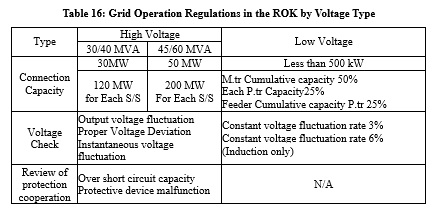
An additional area of regulation related to microgrids are tariff regulation of renewables and generation incentives. These include discount criteria related to the Renewable Energy Tariff. If the ratio of self-consumption of renewable energy is 20% or more, a discount is provided at the level of 50% of the electricity rate saved when self-consuming renewable energy (see Table 17). This regulation was designed to provide additional incentives when installing renewable energy and ESS, and was expanded to apply to capacity-free applications for customers with renewable capacity of 1,000 kW or less.

PV Tariff Offset
PV Tariff Offset Transactions are another area of regulations related to microgrids. The amount of electricity to be produced by a renewable source is established through a contract with the utility company. The trading method for photovoltaic power generation measures electricity generation by additionally installing electricity meters installed for electricity generation (⓷ in Figure 16) and electricity meters for renewable energy generation ⓸. If the amount of electricity generated is greater than the consumption by the household or other small-volume consumer, the remaining amount is subtracted as the difference from the existing measured value and only the remaining cost ⓹ is paid to the utility company.
Figure 16: PV Tariffs and Transactions
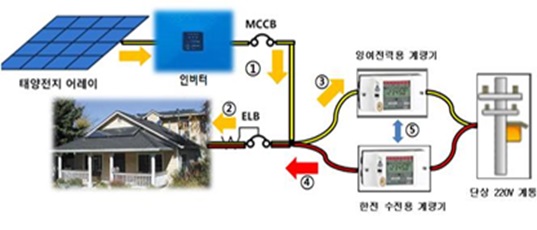
Net Power Cost Calculations
The calculation of net grid power costs to consumers who generate some of their own power with renewable systems is shown in Table 18, below. In general, during the day when electricity can be produced as a new renewable power source, when the amount of solar power generated is more than consumption, it is metered on the surplus meter, and when the amount of electricity generated is smaller than consumption, the net amount consumed is metered on the KEPCO electricity meter. When not generating electricity at night, electricity is metered on the KEPCO meter. Therefore, the fee paid by consumers with renewable energy sources is the difference between the electricity produced by KEPCO and renewable energy sources.
Table 18: Calculation of Generation Fees for Photovoltaic Systems in the ROK
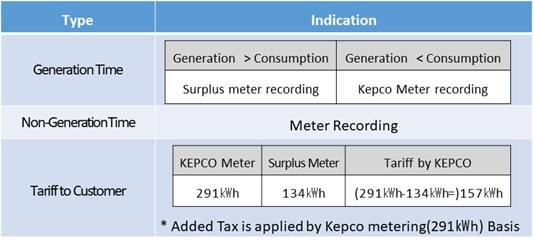
Local Government Energy Transition Ordinance
Along with the central government’s new renewable energy policy, local governments’ participation in energy policy has increased. Local governments have enacted legislation and laws necessary to implement the central government’s policies staring in 2006, and by 2010 more municipalities contributed to the expansion of the energy transition by creating laws and institutions designed to provide goals and incentives for climate change responses and renewable energy deployment, as shown in Table 19.
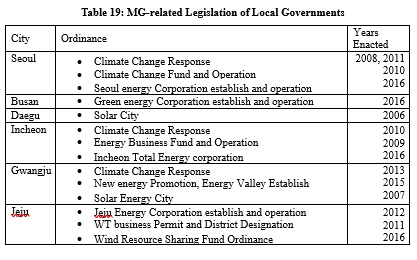
5 MG Financing in the ROK
5.1 Sources of Financing for MGs
The budget for microgrid expansion in the ROK has come mostly from government subsidies and private sector investment. Government grants can be paid up to 70% in cash, and private companies can participate in MG projects with contributions in cash and/or in kind. Private companies can do business with funding from banks or fund companies. Table 20 shows the sources of financing for MGs in the ROK.
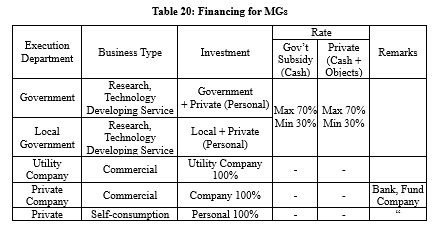
5.2 New Financing Mechanisms for Renewables and Microgrids
In order to expand renewable energy sources and microgrids, there are limits to the potential impacts of national government or local government policies. This is because there is a big difference in the cost of generating using fossil fuels produced on a large scale from those of renewable sources. New renewable power plant equipment is expensive, and the cost of investment is high. Recently, banks and fund companies have launched loan products with real estate collateral to expand renewable energy sources, and the business of specialized renewable power development companies is increasing. Renewable power generation facilities and ESS prices have fallen dramatically in recent years, but it is still difficult to compete with fossil fuels without government subsidies. Therefore, it is necessary to maintain subsidies and continue to develop technologies until the competitiveness of the production facilities for renewable energy sources and microgrids is secured. In addition, the introduction of a policy of lowering the production price through new renewable power generation projects should be carried out in parallel. In this environment, it is necessary to prepare for the transformation of the digital grid.
6 Integrating MGs with the National Grid
Status of MG Expansion
Due to the government’s policy to promote the expansion of the supply of renewable energy, the number of PV + ESS- types MGs are increasing rapidly. As a result, utility companies need to invest a lot in establishing not new transmission and distribution lines but expanding existing facilities such as Substation, Transmission tower and Main Transformer etc. The government, which has to implement the Paris Climate Change Agreement, made access to grids in 2019 for solar installations or less than 1,000 kW.
Microgrids have already been applied in various regions since 2009, and many policy and technical barriers have been removed. Therefore, issues such as frequency and voltage maintenance rarely occur at present. However, more drastic investments must be made nationwide in order to achieve the ROK’s CO2 reduction targets under the Paris Climate Change Convention. Against this backdrop, expansion of renewable sources and microgrids requires strengthening of management to overcome the following three obstacles. And policy support and participation of residents are needed.
Some Hurdles to MG Expansion
In the case of private companies, installing large-scale photovoltaic and ESS near the urban area makes it difficult to secure the site and requires a lot of investment. Existing transmission and distribution facilities in rural are not adjacent to the new investment areas, so the cost of access for new projects is high. Large-scale offshore wind power generation facilities will take a long time for installation, including steps such as site selection, negotiations with and providing for compensation for residents, and plant construction.
A Proposed Solution
Therefore, it is urgent Issue to prepare a project-based manual, a policy for revision related to environmental changes after the initial proposal and/or installation, and a plan for expanding the participation of residents in order to facilitate the promotion of renewable energy sources and microgrid projects. In particular, if the number of MGs as well as electric vehicles increases rapidly in the power grid, massive blackouts may occur due to system instability. In order to solve these risks early, it is necessary to prepare the step-by-step development of a digital grid so that all renewable power sources and electric vehicles can be monitored as they connect or disconnect to the grid, allowing detection in real time and automatic control.
7 Conclusions
Korea’s microgrid has been expanding since 2009 to meet needs such as output stabilization, peak reduction, and demand response for renewable energy sources such as solar power, wind power, and others. The number of MG and ESS installations nationwide has grown to 1,267 sites with 4.3 GWh of total storage. Due in part to the increase in MG, the 7 GW of PV capacity on the grid in the ROK in the summer of 2018 contributed to the suppression of the nation’s rise in peak power demand, and the number of new companies entering the MG business is increasing as well. Increasing microgrids could replace large-scale fossil fuel power plants and long-distance transmission and distribution networks, which would greatly help utilities reduce investment and assist in preventing global warming. The government would need to install 63.5 GW of renewable energy sources nationally to reduce CO2 emissions 37% by 2030. As more ESS is needed for stable operation of the grid, various MG expansion policies should be continued. On the other hand, MG can be unstable in grid operation due to fluctuating weather condition, and massive blackout may be possible. Therefore, it is necessary to research and commercialize \ more advanced digital grid technologies that can manage the power grid in real time.
EPILOGUE: IMPLICATIONS OF COVID-19 PANDEMIC AND RESPONSE FOR ROK DEPLOYMENT OF MICROGRID TECHNOLOGIES
Impact of the andemic on ROK microgrids?
Most Koreans don’t think of this epidemic as related to or affecting the central grid or microgrids. The pandemic is an epidemic, and Koreans have been focused on preventing the spread of infectious diseases and preventing family infections according to government guidelines. However, some authors in universities, research institutions, and the media claim that this epidemic is at least in part due to climate changes related to global warming and greenhouse gas emissions. To address this issue, many ROK decisionmakers emphasize that the current fossil fuel-driven energy supply system must be converted to rely primarily on renewable energy. Converting the ROK energy system, which has been dependent on fossil fuel imports for the last 50 years or more, to renewable energy, however, requires a great deal of investment and many years compared to continuing with the established fossil-fuel based system.
Impact of the pandemic on the rate of renewables growth in the ROK?
From two perspectives, the epidemic will accelerate the expansion of renewable energy in the medium and long term.
First, as in many other nations, the government response designed to contain the epidemic caused an economic downturn, and the government has announced that it would introduce a “green new deal” to help to reinvigorate the economy, in part by making large investments to expand renewable energy supplies and use in the ROK. In this case, the use of renewable energy will expand and spread, reducing the use of fossil fuels in some areas and resulting in a reorganization of the energy industry. Second, expansion of renewable energy is needed to restore or stabilize ecosystems damaged by global warming that is occurring due to increased emissions of carbon dioxide and other greenhouse gases.
Impact of the pandemic on ROK microgrids policy and financing?
The current microgrid policy in the ROK has been focused on expanding renewable energy use for electricity generation. Reinforcement of the national transmission and distribution system is necessary because a rapid increase in the amount of intermittent renewable energy inputs can lead to instability in the central grid. Eventually, when microgrids are operating more widely in the ROK in conjunction with the central grid, policies associated with grid operations and access need to be changed to ensure stable operation of both types of grids. Financial companies in the ROK are already offering financial products required for the expansion of microgrids in the form of long-term low-interest loans.
Impact of the pandemic on vulnerabilities in the ROK energy systems?
When it comes to solving the pandemic with renewable energy, the vulnerability of the central grid or microgrid has not been affected. This is because the scale of renewable energy generation is still small and the existing central grid’s operating system is good. If it is found that pandemic is directly related to global warming, the micro grid will be useful in the short term because it can be used independently to supply power to independent homes or villages. At this time, it is no problem to operate microgrids independently, but if they are operated in conjunction with the central grid, they may cause vulnerability in the power grid protection systems.
Impact of the pandemic on integration of microgrids with KPX/KEPCO central grid?
In Korea, the operations of KPX/KEPCO have not yet been directly affected by the pandemic, but the increase in large-scale microgrids has the potential to affect the stable operation of the central grid. In the case of the Jeju area, curtailment began with the increase of solar power and wind power five years ago. In 2019, the renewable energy operators in Jeju were unable to sell into the grid during a total of 46 Curtailments, with a total of 23 GWh of production being curtailed by KPX and KEPCO. From this point of view, the central grid will feel the need to connect with new microgrids, but it will take time to reinforce the transmission and distribution facilities of the central grid to allow widespread integration of microgrids, and that will require a lot of investment.
Impact of the pandemic on a Green New Deal to respond to the covid-driven recession?
The government is preparing a Green New Deal to respond to the economic recession resulting from measures taken in the ROK to address the COVID-19 pandemic.
The key goal in the Green New Deal is to contribute to the prevention of global warming and to change the fossil fuel-oriented industrial structure into one reliant on renewable energy, thus allowing the ROK to reduce its emissions of carbon dioxide and other greenhouse gases in stages. As an element to accelerate this, the expansion target of renewable energy should be reflected in government policy projections, and policies should make the expansion of renewable energy use mandatory. This expansion requires securing a huge budget for renewable energy investments, introducing a system for investing in renewable energy, and developing suitable areas of renewable resources.
Complementing the existing energy supply infrastructure with renewables, or reorganization of the existing network and its operating procedures to better incorporate renewable resources, are key factors in assuring success in the broad development of renewables in the ROK. Overcoming the obstacle of the current difficulties in integrating renewable generation capacity into the grid on a substantial and effective scale is arguably both a crisis and an opportunity for the ROK. I think that the effort required to overcome these challenges will be great as the crisis is difficult to overcome.
Ultimately, the ROK government will likely try to solve the energy/climate change problem by spreading the use of renewable generation microgrids and making policy and technical changes to accommodate microgrids within the central grid network as other developed countries are trying to do.
III. NAUTILUS INVITES YOUR RESPONSE
The Nautilus Asia Peace and Security Network invites your responses to this report. Please send responses to: nautilus@nautilus.org. Responses will be considered for redistribution to the network only if they include the author’s name, affiliation, and explicit consent.


